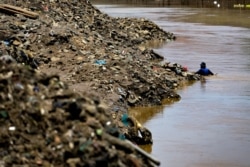The United States contributes much more to ocean plastic pollution than previously estimated, according to a new study.
“Plastic pollution is … one of the three major threats to the future health of the oceans,” said George Leonard, chief scientist at Ocean Conservancy and a co-author of the study. “Plastics are basically finding their way into the entirety of the marine food web — everything from the smallest phytoplankton at the base of the food web right up through the fish that we eat to the largest marine mammals and seabirds and sea turtles.”
The U.S. generated a staggering 42 million metric tons of plastic waste in 2016 — more than any other country in the world, according to the analysis.
Up to 2.2 million metric tons of this waste ended up in the ocean. If piled on the White House lawn, it “would soar as high as the Empire State Building,” said Leonard.
A previous study by the same research group ranked the U.S. as the 20th-biggest contributor to ocean plastic, but they considered littering the sole source of this pollution. Including two other sources of pollution — illegal dumping and waste that’s shipped abroad for recycling, but ultimately ends up in the environment — the new study boosts the U.S. to third place for worst plastic-polluting nations.
“This paper is really good because it puts the U.S. back at the top of the list and says ‘Hey, wait, the U.S. is a major source of plastic pollution,’” said Jan Dell, chemical engineer and founder of The Last Beach Cleanup, who did not contribute to the research.
In 2016, the U.S. recycled just 9% of its total plastic waste. About half of this was recycled domestically and half was shipped overseas. The researchers estimate that up to 1 million metric tons of U.S. plastic waste entered the environment from these exports in 2016.
“For years, so much of the plastic we have put into the blue bin has been exported for recycling to countries that struggle to manage their own waste, let alone the vast amounts delivered from the United States,” said Kara Lavender Law, research professor of oceanography at Sea Education Association and lead author of the study, in a statement.
“And when you consider how much of our plastic waste isn’t actually recyclable because it is low-value, contaminated or difficult to process, it’s not surprising that a lot of it ends up polluting the environment.”
On U.S. soil, littering and illegal dumping contributed another 1.2 million metric tons of plastic pollution.
In a statement, plastics industry trade group the American Chemistry Council (ACC) agreed that “plastic waste in our environment is not acceptable, and America's plastic makers are working to quickly advance responsible solutions to address this issue.”
ACC's vice president of plastics, Joshua Baca, said the industry had set a goal that all U.S. plastic packaging be reused, recycled or recovered by 2040. Baca added that U.S. waste exports have fallen by nearly 70% since 2016.
However, the study notes, that decline is primarily due to China’s ban on imported plastic waste. Since this ban came into effect in 2017, U.S. waste shipments to countries such as Malaysia, Vietnam and Thailand have soared, according to a Financial Times investigation.
“The United States is a leader in causing the plastic pollution crisis in the world. And this data proves it. It's through our plastic pollution at home as well as our exports. The simplest solution for exports is to stop exporting,” said Dell. “This is our waste. We should keep it at home and work to make less [waste].”
Researchers say that an overhaul of plastic manufacturing, consumption and recycling are needed to address the plastic crisis.
“We’re seeing even now a skyrocketing, a vertical climb, in the amount of trash on the ocean surface,” said Marcus Eriksen, research director and co-founder of the 5 Gyres Institute, who was not involved with the study. “We need to get smarter about how much plastic we’re using and how much we’re losing to the environment.”
To help tackle ocean plastic pollution, the U.S. Senate passed the Save Our Seas 2.0 Act earlier this year.
“The Save Our Seas 2.0 is a key stepping stone in the right direction toward comprehensive solutions that address marine debris. But in its current form, however, it does not address the reduction step that is critically needed ... for us to get a handle on this,” said Nick Mallos, senior director of Ocean Conservancy’s Trash Free Seas program and a co-author of the study, during a press conference. “Reducing plastic waste is critical to avoiding an unmanageable plastic future globally.”
Although plastic pollution is a global problem, researchers say that individual actions can make a difference.
“Doing everything you can to reduce your own plastic footprint, whether that’s using a reusable shopping bag or a reusable coffee mug, and then just sort of minimizing the single use plastics you use can be part of the solution,” said Ocean Conservancy’s Leonard.






